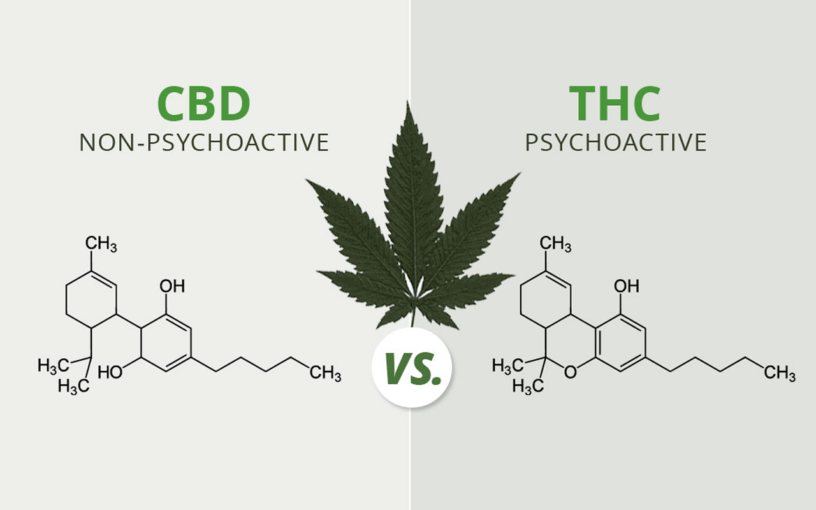CBD vs. THC found in Marijuana
CBD and THC are the two most abundant cannabinoids found in Cannabis. They both interact with the body’s endocannabinoid system but elicit very different natural effects.
Cannabidiol (CBD) and Tetrahydrocannabinol (THC) are the two most prominent cannabinoids found in Cannabis, the plant genus that includes both Hemp and Marijuana. While there are over 100+ different cannabinoids that have been identified by scientist so far, CBD and THC are by far the most widely studied and the best understood.
CBD and THC both interact with the body through the Endocannabinoid system (ECS), a vital signaling system responsible for regulating a wide array of functions, including:
- Pain
- Appetite
- Mood
- Memory
- Immune response
- Sleep
- Cycles of cellular life and death
Their chemical makeups are similar to the body’s own Endocannabinoids, which allow them to interact with the Endocannabinoid system’s cannabinoid receptors to alter the release of neurotransmitters in the brain.
Despite their similarities, CBD and THC have distinct differences that influence how they interact with the Endocannabinoid system, and subsequently the natural effects they elicit.
Psychoactive Vs. Non-Psychoactive
One of the key differences between CBD and THC is whether the cannabinoid will cause a euphoric effect, or “high,” when consumed.
THC is the cannabinoid people think of when they think of Marijuana. It is a direct agonist of the Endocannabinoid system’s cannabinoid 1 receptors (CB1), found primarily in the brain and the central nervous system. The psychoactive effect is what most people associate with recreational or medical marijuana use. This feeling is exclusively brought about by activating CB1 receptors.
CBD doesn’t bind with CB1 receptors and is actually is considered an antagonist of CB1 agonists. This not only means that CBD can never cause a high, no matter how much is consumed, but that it also acts to suppress the CB1-activating qualities of compounds like THC.
THC Dominates Marijuana, CBD Dominates Hemp
CBD and THC are both found throughout the seeds, stalks, and flowers of both Hemp and Marijuana. The two exist in cannabis plants in a wide range of proportions. However, while THC is most plentiful in Marijuana, CBD is present in higher quantities in Hemp.
In Marijuana, THC dominates the plant’s chemical makeup. Marijuana is generally cultivated specifically to maximize its THC content. Over many decades, Marijuana has been manipulated and cloned with particular emphasis on increasing its THC concentration and producing more powerful intoxicating effects. While THC content can be as low as 3 percent in Marijuana, on average, Marijuana strains today contain approximately 12% THC.
On the other hand, Hemp’s chemical makeup is dominated by CBD. By definition, Hemp’s THC content is no more than 0.3% THC, nearly 10 times less than the least potent strain of Marijuana. Instead, Hemp naturally has more CBD vs. THC, making it an ideal source of CBD from cannabis.
Interaction with Cannabinoid Receptors
CBD and THC both interact with the body’s Endocannabinoid system and its specialized cannabinoid receptors, CB1 and CB2. It is through these interactions that these two cannabinoids augment the Endocannabinoid system and encourage balance. However, the ways in which the two cannabinoids interact with these cannabinoid receptors vary.
THC directly binds with both CB1 and CB2 receptors, while having a higher affinity for CB1 receptors.
CBD has little affinity for the two cannabinoid receptors. Instead, it acts as an indirect antagonist of cannabinoid agonists. This means that CBD acts to suppress the CB1 and CB2 activating qualities of a cannabinoid like THC. CBD has also been found to interact with other non-cannabinoid receptors, including 5-HT1A receptors and the vanilloid receptor TRPV-1.
Legal Status: THC vs. CBD
The legality of cannabinoid products in the United States is dependent on their concentration and source.
Marijuana and THC are both specifically listed in the U.S. Controlled Substances Act and therefore prohibited under federal law. Twenty-nine U.S. states and Washington D.C. have passed their own cannabis policies permitting the use of medical Marijuana with high levels of THC, provided it’s recommended by a licensed physician. Eight of those states and Washington D.C. have gone a step further and legalized the recreational use of Marijuana and THC.
CBD is legally available in the United States, but it must be derived from imported high-CBD, low-THC Hemp. CBD itself it not listed under the Controlled Substances Act, so it’s legal in all 50 states provided it’s not extracted from Marijuana.
If derived from Marijuana, CBD is illegal unless obtained through a state-regulated medical Marijuana program or in a state that permits recreational Marijuana use. CBD products derived from Hemp are considered dietary supplements in the U.S. and legal to buy and sell.
Side Effects and Safety: CBD Vs. THC
The psychoactive properties of THC can cause temporary side effects:
- Memory impairments
- Lowered reaction time
- Increased heart rate
- Coordination problems
- Dry mouth
- Red eyes
While there is a risk of some negative side effects from THC, according to the National Cancer Institute it is not possible to have a fatal overdose. Some studies have found evidence that cannabis strains high in THC can cause long-term negative psychiatric effects when consumed by adolescents, including increasing the risk of psychiatric disorders like schizophrenia.
Research indicates even large doses of CBD are well tolerated and safe. There have been some reports of dry mouth, light-headedness, and drowsiness. A recent research review examining the safety and side effects of CBD concluded that CBD appeared to be safe in humans and animals. Even chronic use of CBD by humans showed to cause no adverse neurological, psychiatric, or clinical effects.

